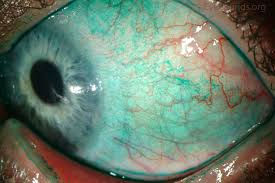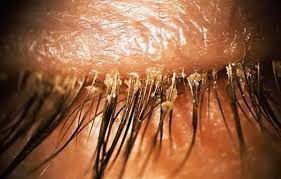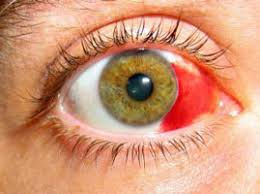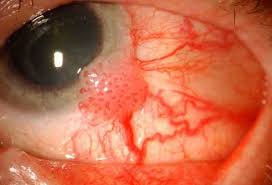
Red/Sore Eye(s)
 |
|---|
Red/Sore Eye(s)

What eye diseases/conditions are associated with Red/Sore Eye(s)?
Diagnosing Red/Sore Eye(s):
Acute Red Eye
Rule out:

Uveitis / Iritis

Angle-Closure Glaucoma

Superficial Keratitis
YES
Eye Pain?
NO
Blurred Vision?
NO
Photophobia?
YES
YES
NO
Discharge?
YES
NO

Dry Eye Syndrome

Blepharitis

Pinguecula / Pterygia

Subconjunctival Hemorrhage

Conjunctival Tumor

Bacterial Conjunctivitis

Gonococcal Conjunctivitis
Purulent
Watery
Itchy?
Hyperpurulent
NO
YES
Rule out:

Allergic Conjunctivitis
Viral Conjunctivitis

Adenoviral Conjunctivitis

Herpetic Keratoconjunctivitis

Episcleritis

Scleritis
As you can see there are a lot of causes of red/sore eyes, which makes diagnosing the exact cause difficult at times. The first step is to rule out environmental causes like smoking, computer use, and contact lens use. Contact Lenses cause many red eye conditions: CLARE (contact-lens induced acute red eye), bacterial infection/corneal ulcer, and corneal neovascularization). The next step is to rule out an accident (trauma, foreign bodies, and chemical burns). The rest can be fairly well navigated by using symptoms to guide the differential diagnosis. See the flow chart above.
Symptoms are important in distinguishing between many of the conditions above, but presentation (or signs) may be even more important. One of the most common causes of ocular redness is pink eye or viral conjunctivitis. Differential diagnoses for viral conjunctivitis include bacterial conjunctivitis, allergic conjunctivitis, and herpetic viral keratoconjunctivitis amongst others. The symptoms that most differentiate these diagnoses are 1) the type of discharge and 2) present or absent itchiness.
Lots of patients go to their primary care doctors or an urgent care clinic when they suspect pink eye. However, these nurse practitioners, physician assistants, and doctors don't have the necessary equipment to most accurately diagnose eye problems, and often use antibiotic drops to treat a viral condition. While the antibiotic drops don't hurt, and can actually prevent superinfection they aren't as affective as other treatments. An in-office treatment utilizing a diluted Betadine solution, decreases the length of time the patient is symptomatic. The Betadine kills the virus immediately making it a better solution. Steroid drops are prescribed after the Betadine treatment to minimize inflammation.
With any new or worsening ocular redness, we recommend seeing our Doctor for evaluation and management of the condition. Treatment options differ greatly depending on the structures of the eye(s) that are affected and on the cause of the redness. If experiencing a red/sore eye call to schedule an appointment today.
